Key takeaways:
- Emphasized the importance of using prepared statements and parameterized queries to prevent SQL injection and enhance performance.
- Highlighted the necessity of regular security audits and staying current with software updates to mitigate vulnerabilities.
- Advocated for input validation techniques, including the use of regular expressions and user feedback, to improve security and user experience.
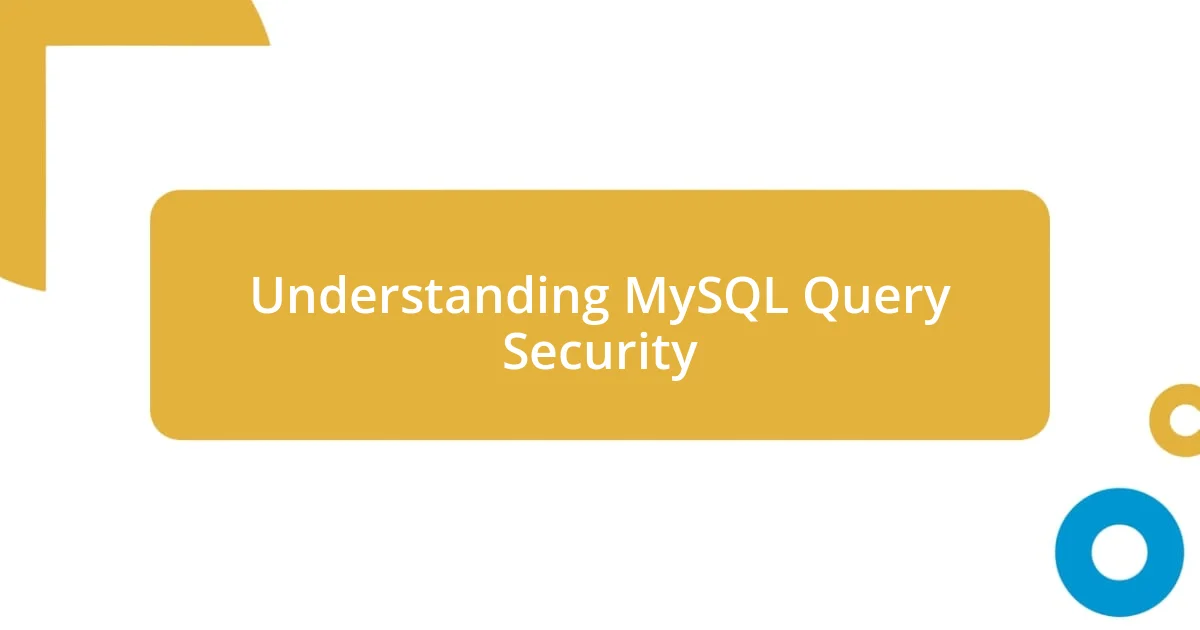
Understanding MySQL Query Security
When it comes to MySQL query security, I’ve often found myself reflecting on the balance between access and protection. Just think about it: as developers, we’re often eager to enable user interactions, yet we must remain vigilant against threats like SQL injection. It’s a challenge that requires both technical knowledge and a keen intuition about how our systems can be exploited.
One experience that stands out for me was when I had to conduct a security audit on an application that used MySQL. I was shocked to discover how simple it was for someone to manipulate user inputs to gain unauthorized access. This highlighted for me the importance of using prepared statements and parameterized queries, which not only safeguard data but also boost performance. Have you ever encountered a similar situation where the stakes felt high?
I’ve learned that security isn’t just about implementing the right measures; it’s also about cultivating an awareness of potential vulnerabilities in query design. Every time I write a query, I make it a habit to ask myself: “Is this query safe from all angles?” Thinking critically like this has helped me build a robust security mindset throughout my projects.
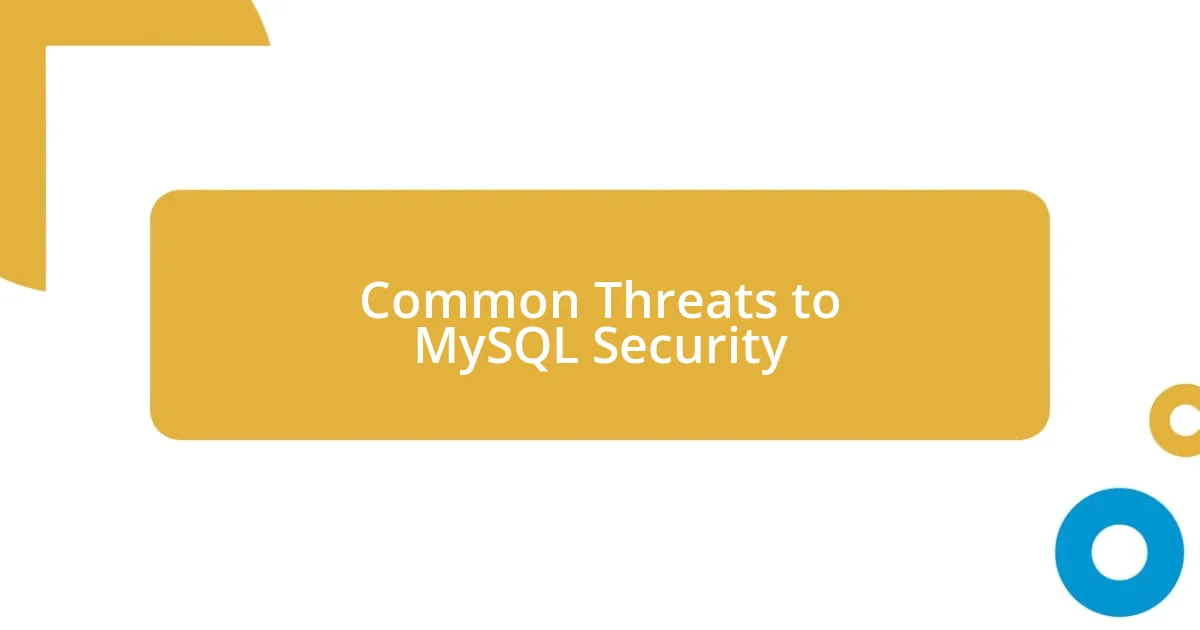
Common Threats to MySQL Security
When I think about common threats to MySQL security, SQL injection immediately springs to mind. This attack vector exploits vulnerabilities in an application’s software, enabling malicious users to manipulate SQL queries. I once had a colleague who, in a rush to deploy a feature, overlooked user input sanitization. As a result, they faced a costly data breach that could’ve been avoided with thorough input validation.
Another threat that can’t be ignored is insufficient access controls. It’s astonishing how often I’ve seen applications with overly permissive user privileges. My own experience taught me to regularly review and refine user permissions. I remember working late one evening, only to find a user had access to sensitive information they didn’t need. This prompted a serious revisiting of our access control measures—a step that has since become part of my routine.
Finally, remember that outdated software can be a silent enemy. I learned this the hard way when a critical vulnerability was discovered in an old MySQL version we were still using. One day, I received an alert about a potential exploit targeted at our databases. We acted quickly to update, but it served as a vivid reminder: staying current with software versions is crucial in safeguarding against evolving threats.
| Threat Type | Description |
|---|---|
| SQL Injection | Exploits weaknesses in user input handling to manipulate queries. |
| Insufficient Access Controls | Overly permissive privileges leading to unauthorized data access. |
| Outdated Software | Older versions of MySQL can harbor known vulnerabilities. |
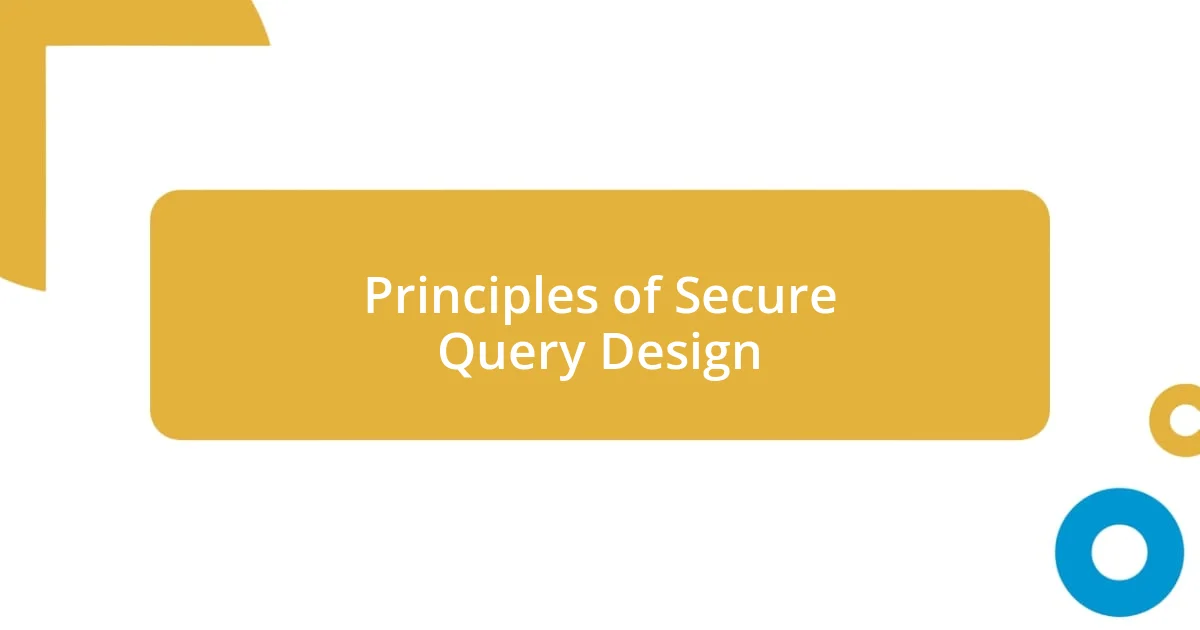
Principles of Secure Query Design
I firmly believe that secure query design hinges on a few core principles that should be at the forefront of any developer’s mind. For me, one of the most critical aspects is input validation. I once worked on a project where we initially neglected this, and it cost us a lot of sleepless nights when we had to patch vulnerabilities post-deployment. Implementing rigorous validation processes not only shields against injection attacks but also fosters user trust.
- Use Prepared Statements: These are essential for separating SQL code from user input, which drastically reduces injection risks.
- Limit Data Access: Always adhere to the principle of least privilege; users should only have the access necessary for their role.
- Sanitize User Inputs: Properly escape or filter out harmful inputs to prevent malicious code injection.
- Regular Reviews and Testing: Frequent audits of queries and overall security measures help catch potential vulnerabilities before they become issues.
In my experience, keeping queries simple and direct also contributes significantly to security. A few years ago, I revamped a project plagued by complex query structures that were difficult to follow. Simplifying the design not only made the code easier to maintain but also reduced the surface area for potential attacks. It’s remarkable how clarity in design can enhance security, allowing developers to identify and mitigate threats swiftly.
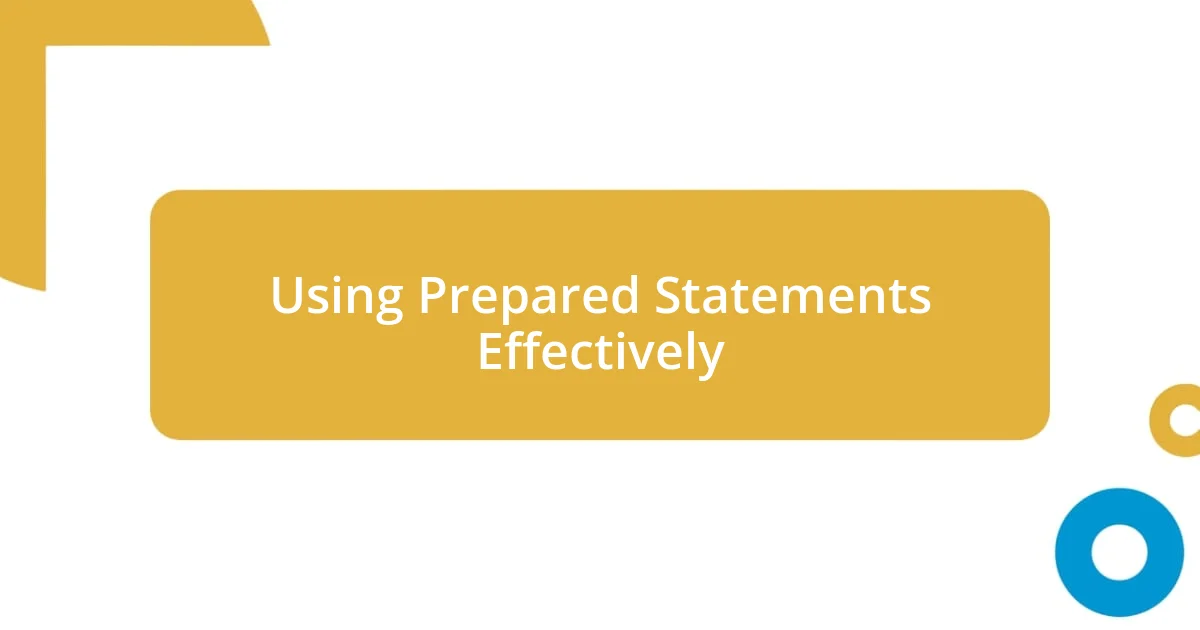
Using Prepared Statements Effectively
Prepared statements have been a game-changer in my approach to securing MySQL queries. I remember the first time I integrated them into a project; it felt like flipping a switch. By using placeholders for user input, I significantly minimized the risk of SQL injection. It was a relief knowing that even if malicious inputs came through, they wouldn’t affect the integrity of my SQL logic. Have you ever experienced that weight lift off your shoulders when you know your code is more secure?
One of the best practices I’ve learned is to always bind parameters when using prepared statements. I can’t stress enough how this practice keeps unwanted data manipulation at bay. There was a time when I used to send raw values directly to the database, thinking it was convenient. After a minor but unnerving scare from an attempted injection, I realized the importance of consistently binding parameters. Not only does it protect your application, but it also makes maintenance easier because you can see where data inputs fit into the query structure. Isn’t it fascinating how a small shift in how we code can lead to such a big impact?
Lastly, I make it a point to combine the use of prepared statements with other security measures. For instance, I always validate that user inputs conform to expected formats before processing them. During a project involving user-generated content, I set strict rules for what kinds of data could be submitted. This act of validation, paired with prepared statements, created a robust shield against potential threats. Sometimes I wonder, can we ever be too cautious when it comes to security? I’ve learned that the answer is a resounding no. Each layer of security we add, however small, contributes to a much stronger overall defense.
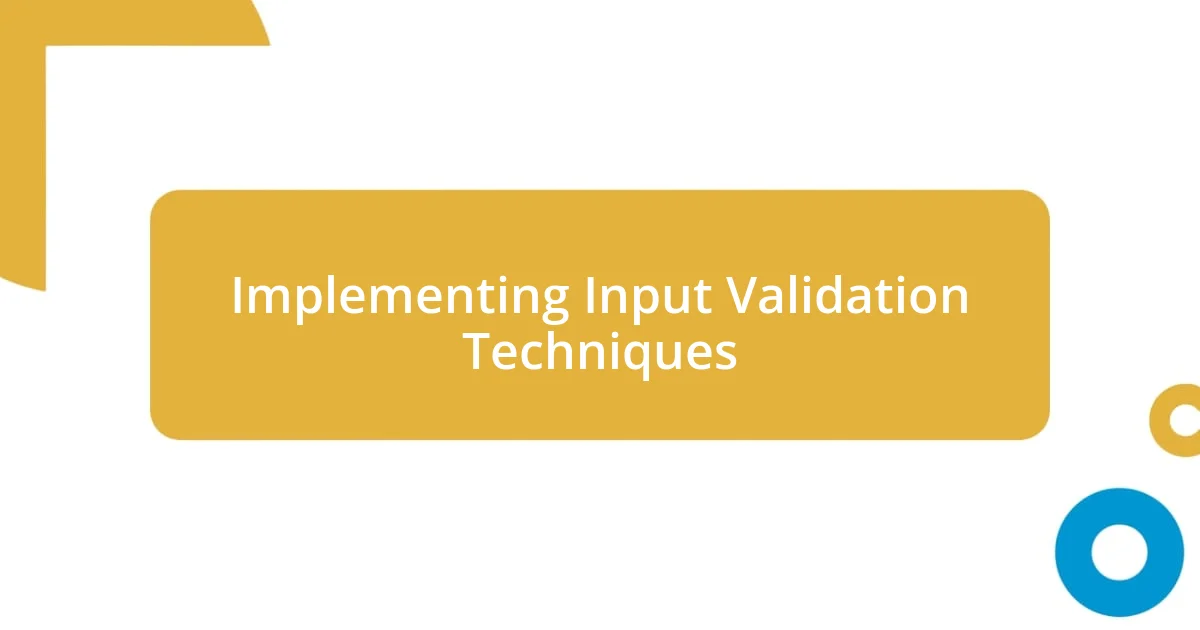
Implementing Input Validation Techniques
I can’t stress enough how crucial input validation has been in my own projects. I remember a time when I faced an issue with user inputs that wreaked havoc on my database. After that experience, I made it a priority to define clear validation rules. Whenever users submitted data, I set strict parameters, ensuring that anything outside of these boundaries was automatically rejected. It was a relief to know that I had taken control of what could enter my systems.
Another method I embraced is the use of regular expressions for more complex validation scenarios. At first, I was intimidated by regex syntax, but once I got the hang of it, I found it incredibly powerful. I designed patterns to match specific formats, like email addresses or phone numbers, which helped filter out unexpected inputs effectively. Is there anything more satisfying than creating a validation system that feels almost foolproof? I discovered that success often lies not just in catching errors, but in anticipating them before they happen.
Moreover, I’ve learned the importance of user feedback in the validation process. Early on, I would simply reject inputs that didn’t match my criteria without explanation. Over time, I realized that offering users helpful messages about why their input was invalid made a world of difference. It led to a better user experience and a significant decrease in repetitive mistakes. I mean, isn’t the goal of development not only to ensure security but also to create solutions that users appreciate? By valuing input validation, I’ve cultivated a culture of trust with my users, and it’s made my applications considerably more resilient.
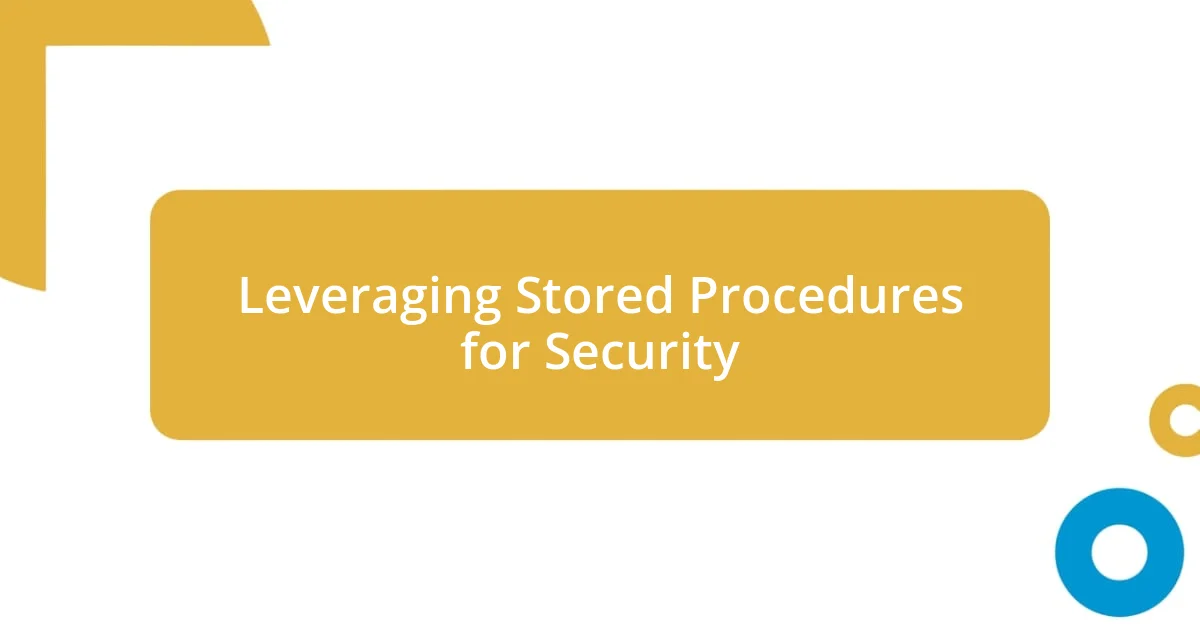
Leveraging Stored Procedures for Security
When it comes to leveraging stored procedures for security, I’ve found them to be invaluable in creating a controlled environment for database interactions. I vividly recall a project where I replaced ad-hoc queries with stored procedures. Not only did this simplify my code, but it also helped isolate the business logic from user inputs. Have you ever considered how much cleaner and safer your code could be with this method? It’s like having a trusted intermediary that handles all interactions with the database securely.
One of the key benefits of stored procedures is that they reduce the risk of SQL injection attacks because user inputs are handled as parameters rather than being concatenated into queries. I learned this the hard way when I unwittingly exposed a vulnerable endpoint. Once I switched to stored procedures, it felt like wrapping my database in a protective layer. The sense of security I gained was almost palpable; it was a game-changer in how I approached database design. How often do we underestimate the power of good structure?
Moreover, maintaining stored procedures allows for centralized security policies. Whenever I need to modify access rights or tighten controls, I can do so in one place, ensuring consistency across the board. There was a particularly hectic moment during an audit when I realized all the changes I had made enhanced our security posture without disrupting user experience. Isn’t it liberating to know that one efficient update can impact your entire system positively? This is a clear reminder that investing time in securing our database architecture can yield significant returns in safety and maintainability.
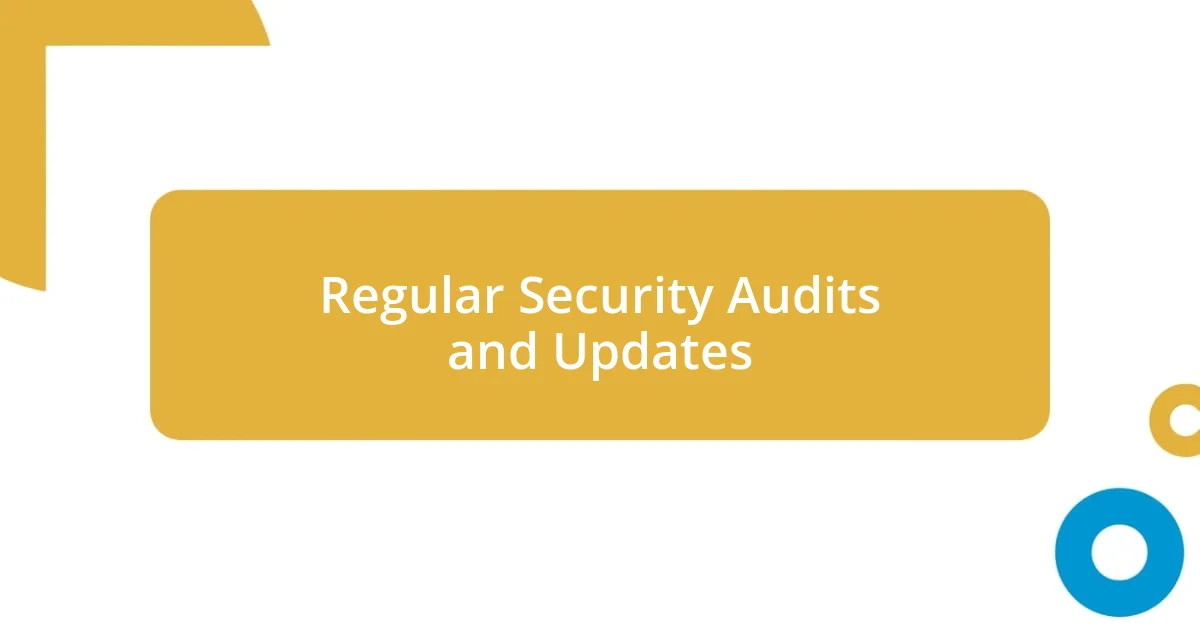
Regular Security Audits and Updates
Regular security audits are my safety net in database management. Each time I conduct one, I feel a mix of nervousness and excitement. I remember a particularly insightful audit where I discovered outdated permissions that could have led to unauthorized access. It’s astonishing how much you can overlook, isn’t it? Regularly assessing security not only identifies vulnerabilities but also reinforces the importance of diligence in maintaining database integrity.
Coupled with audits, I ensure that updates are part of my routine. Upgrading MySQL or applying patches may seem tedious, but I’ve learned that it’s a small price to pay for peace of mind. I once skipped a minor update due to time constraints, only to find myself battling a significant security breach later. It reinforced my belief that proactive measures, like staying current with updates, are essential to preventing larger issues. Have you ever had a similar revelation that changed how you approach maintenance?
Incorporating findings from my audits into regular update cycles has improved my overall security strategy. After each audit, I take notes, prioritize necessary updates, and set a timeline for implementation. I recall a project where a simple update fixed a glaring vulnerability I didn’t even know existed! It’s moments like that which drive home the importance of being proactive rather than reactive. Does it ever surprise you how connected ongoing vigilance and timely updates really are? For me, they form the backbone of a resilient database security framework.














